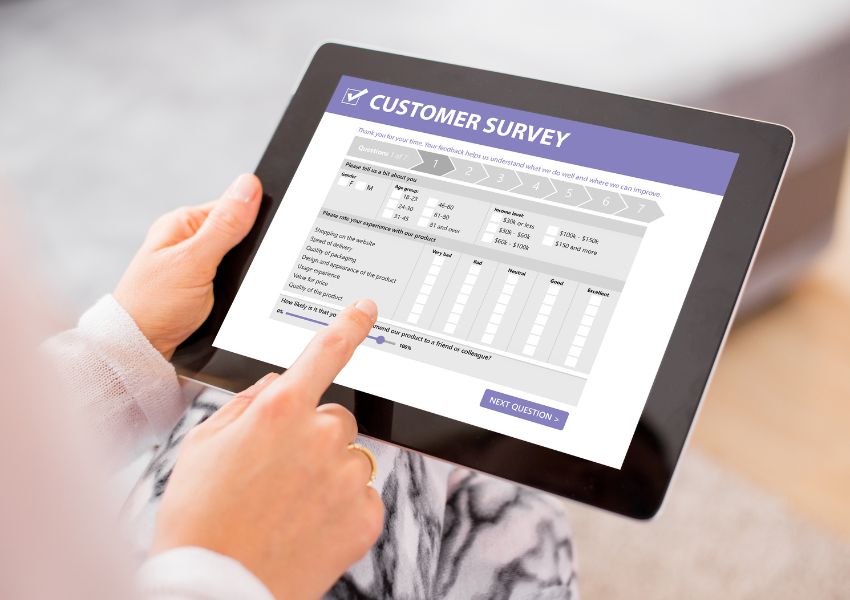In today’s fast-paced business world, understanding your customers’ needs and preferences is crucial for success. One powerful tool that businesses often overlook is the use of expressive language to enhance customer feedback.
This article delves into the art of using expressive language to gather valuable insights from your customers, improve your products or services, and foster stronger customer relationships.
The Importance of Customer Feedback
Before we dive into the role of expressive language, let’s first understand why customer feedback matters. Customer feedback is the lifeblood of any business, providing invaluable insights that can help you make informed decisions and improvements. It helps you:
- Identify areas for improvement
- Enhance product or service quality
- Understand customer preferences
- Build brand loyalty
- Increase customer satisfaction
- Stay competitive in the market
Expressive Language: A Game-Changer in Customer Feedback
Expressive language involves using vivid, descriptive, and emotionally charged words and phrases to communicate ideas and emotions effectively. When applied to customer feedback, it can transform mundane comments into rich sources of information.
1. Engage with Emotion
When it comes to customer feedback, emotions play a significant role. Customers aren’t just providing factual information; they are sharing their experiences, and these experiences are often laden with emotions. To truly understand and connect with your customers, it’s essential to engage with these emotions.
Instead of using generic language to describe their experiences, encourage customers to express their feelings. For instance, if a customer had a great experience at your restaurant, they can go beyond saying, “The food was excellent.” They might use more expressive language, such as “The food was absolutely delectable, and it made my evening truly special.”
By encouraging customers to engage with their emotions, you gain deeper insights into their experiences, and it also shows that you value their feelings and opinions.
2. Expressing Satisfaction Creatively
To encourage more detailed responses, use creative ways to say you like something or to ask customers for feedback about your service. For example, instead of a generic “What do you like about our product?” you can ask, “What aspects of our product bring a smile to your face?” This playful approach can evoke specific, detailed responses that go beyond the surface.
Here are some examples:
It was a delight: This phrase adds a touch of sophistication and indicates a high level of satisfaction.
I was thrilled: Expressing a thrill conveys excitement and a strong positive reaction.
It exceeded my expectations: When something surpasses expectations, it’s worth celebrating.
I couldn’t get enough: This phrase implies that the experience was so enjoyable that the customer wanted more.
It was a pleasant surprise: This suggests that the experience went above and beyond what the customer anticipated.
I was on cloud nine: This idiom is a playful way to express extreme happiness or satisfaction.
I was over the moon: Similar to “on cloud nine,” this phrase indicates great joy.
It made my day: When something positively impacts someone’s day, it’s a powerful complement.
By encouraging customers to use creative expressions like these, you not only receive feedback but also create a more engaging and enjoyable interaction.
Ready to enhance customer feedback with the help of expressive language?
Contact Growth Hackers
3. Show Empathy and Appreciation
One of the key advantages of building a successful business strategy is using expressive language in customer feedback, which has the ability to convey empathy and appreciation. When customers take the time to express their experiences in detail, it’s an opportunity for your business to respond with genuine empathy and appreciation.
Responding to feedback with expressions of empathy can include phrases like:
- “Thank you for sharing your experience with us.”
- “We understand how that situation could have been frustrating, and we appreciate your patience.”
Showing appreciation for feedback, whether positive or negative, lets customers know that their voices are heard and valued. It also provides an opportunity to address any issues and showcase your commitment to customer satisfaction.
Examples of Expressive Language in Action
Let’s explore a few examples of how businesses can use expressive language to enhance customer feedback.
Example 1: Restaurant Feedback
Standard Request: “How was your dining experience?”
Expressive Request: “We hope you had a delightful dining experience with us. Can you share the flavors, dishes, or moments that stood out to you?”
Example 2: E-commerce Feedback
Standard Request: “Tell us about your shopping experience.”
Expressive Request: “We appreciate your choice to shop with us. Could you describe the shopping journey—any exciting finds, memorable moments, or products that made your day?”
Example 3: Software Feedback
Standard Request: “What do you think of our software?”
Expressive Request: “We’re thrilled to be part of your digital journey. Can you share your thoughts on how our software has impacted your workflow or made tasks more enjoyable?”
4. Personalize Your Feedback
Personalization is a key aspect of effective customer feedback. When customers feel that their feedback is not just heard but also understood on a personal level, it fosters a deeper connection and trust between the business and the customer. Here are some ways to personalize your feedback using expressive language:
- Address Customers by Name: Whenever possible, use the customer’s name in your responses. This simple act adds a personal touch to your communication and shows that you acknowledge them as an individual.
- Reference Specific Interactions: Mention specific interactions or transactions that the customer had with your business. This not only confirms that you’ve reviewed their feedback but also demonstrates that you value their unique experience.
- Use Relatable Language: Tailor your language to the customer’s preferences and style. If they use informal language in their feedback, respond in a similar manner. If they prefer a more formal tone, adjust your response accordingly.
- Express Genuine Interest: Show sincere interest in the customer’s concerns or positive experiences. Use phrases like “We genuinely appreciate your feedback” or “We’re thrilled to hear about your positive experience.”
Personalizing your feedback demonstrates that you care about each customer as an individual, making them more likely to continue doing business with you.
5. Overcoming Language Barriers
In today’s globalized world, businesses often interact with customers from diverse linguistic backgrounds. Overcoming language barriers is essential to ensuring that all customers receive clear and meaningful feedback. Here’s how expressive language can help bridge these gaps:
- Simplify Complex Ideas: When dealing with customers who may not be fluent in your language, use straightforward and simple language. Avoid jargon and technical terms that could confuse them. Instead, focus on conveying the core message.
- Visual Aids and Context: Use visual aids, such as images or diagrams, to complement your feedback. These can help convey information more effectively, even if there’s a language barrier. Additionally, provide context for your responses to ensure that customers understand the bigger picture.
- Multilingual Support: If your business serves a multilingual customer base, consider offering multilingual support. Having customer service representatives who can communicate in various languages or use translation tools can greatly improve the customer experience.
- Translated Responses: When necessary, provide translated versions of your feedback. This demonstrates your commitment to serving diverse customers and ensures that language differences do not hinder effective communication.
By addressing language barriers and making an effort to communicate clearly and respectfully, your business can create a more inclusive and customer-friendly environment.
Revolutionize your customer feedback—unleash the power of expressive language today!
6. Encourage Constructive Dialogue
Engaging in a constructive dialogue with customers is a valuable aspect of customer feedback. Expressive language can play a pivotal role in maintaining a positive and productive conversation. Here’s how to foster constructive dialogue:
- Acknowledge Concerns with Empathy: When customers express concerns or dissatisfaction, respond with empathy. Use phrases like “I understand your frustration” or “I’m sorry to hear that you had this experience.” Acknowledging their emotions shows that you care about their concerns.
- Offer Solutions and Alternatives: Rather than simply acknowledging issues, provide practical solutions or alternatives. Expressive language can be used to convey that you are actively working to resolve the problem. Phrases like “Here’s what we can do to address this” or “Would you prefer this option instead?” show your commitment to finding a resolution.
- Listen Actively: Encourage customers to share more details about their experiences. Use phrases like “Please tell me more” or “Your insights are valuable.” Actively listening and seeking additional information demonstrates your dedication to understanding their perspective.
- Express Gratitude for Feedback: Regardless of whether the feedback is positive or negative, express gratitude for their input. Use phrases like “Thank you for taking the time to share your thoughts” or “We appreciate your feedback.” This appreciation encourages customers to continue providing feedback.
7. Leverage Technology for Enhanced Feedback
In today’s digital age, technology offers numerous tools and platforms to gather and analyze customer feedback. Leveraging these resources can significantly enhance your ability to collect and act upon customer insights. Here’s how technology and expressive language can work together:
- Online Surveys and Forms: Use online surveys and feedback forms to gather structured feedback from customers. When designing these surveys, incorporate expressive language in the questions and response options. For example, instead of a standard rating scale, use phrases like “How satisfied are you with our service?” with options ranging from “Extremely satisfied” to “Extremely dissatisfied.”
- AI-Powered Analytics: Utilize AI-powered analytics tools to process and interpret customer feedback in real-time. Expressive language can be used to craft AI-generated responses that address common concerns or inquiries. These responses should sound natural and empathetic.
- Social Media Listening: Monitor social media platforms for customer feedback and mentions of your brand. Respond promptly with expressive language to show that you are actively engaged with your audience. Address both positive comments and concerns to maintain a positive online reputation.
- Chatbots and Virtual Assistants: Implement chatbots or virtual assistants on your website or app to provide immediate responses to customer inquiries. Ensure that the language used by these automated systems is warm, helpful, and empathetic.
- Language Learning Apps: Additionally, consider integrating language learning apps such as Promova and Duolingo into your customer support processes. These apps can help your team members improve their language skills, allowing them to communicate with customers more effectively, especially when dealing with multilingual guests. By investing in language learning apps, you can further enhance your ability to provide exceptional customer feedback tailored to diverse language needs.
By harnessing the capabilities of technology and combining them with expressive language, businesses can streamline the feedback collection process and enhance the overall customer experience.
Final Thoughts about How to Enhance Customer Feedback with the Help of Expressive Language
Effective customer feedback is essential for businesses looking to grow and thrive. Expressive language offers a powerful tool to unlock deeper insights, connect with customers on a personal level, and foster a culture of continuous improvement. By engaging with emotion, using creative ways to ask questions, and showing empathy and appreciation, you can enhance your customer feedback process and build stronger relationships with those who matter most—your customers.
So, embrace the art of expressive language and transform your customer feedback into a valuable asset that propels your business forward.
Growth Hackers offers top-notch customer experience services helping businesses from all over the world grow. There is no fluff with Growth Hackers. We help entrepreneurs and business owners enhance customer feedback, increase their productivity, generate qualified leads, optimize their conversion rate, gather and analyze data analytics, acquire and retain users and increase sales. We go further than brand awareness and exposure. We make sure that the strategies we implement move the needle so your business grow, strive and succeed. If you too want your business to reach new heights, contact Growth Hackers today so we can discuss about your brand and create a custom growth plan for you. You’re just one click away to skyrocket your business.







